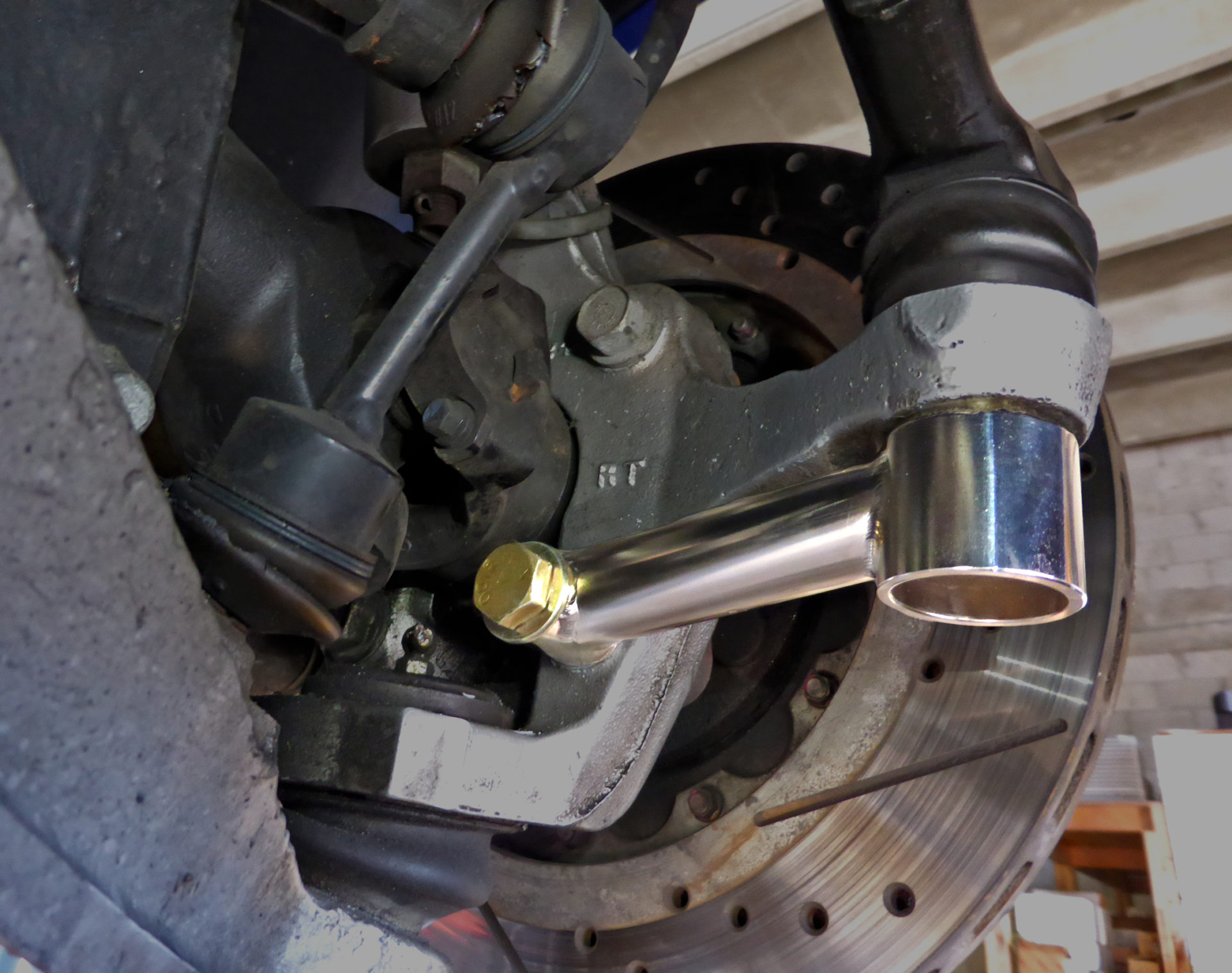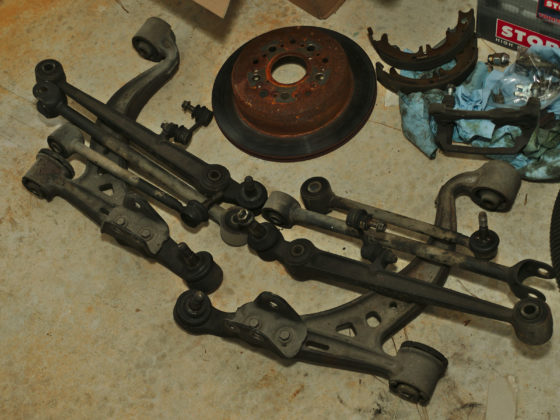The Gen 2 Viper has a pretty serious, fundamental flaw that’s not widely known. The rear toe deflects by HALF AN INCH under hard cornering and acceleration. Unfortunately most of the “anti-toe brackets” out in the market do not properly address the problem or even make a difference. EMI Racing not only found the true cause of the problem, but solved it with their Toe Stiffeners that greatly improve the handling, consistency and safety of the car.
The Dodge Viper has a bad reputation for being hard to drive, despite inexperienced journalists and professionals alike turning blindingly fast lap times and beating the Viper’s ‘easier to drive’ competitors on the racetrack. As we found out in Part 3: Baseline Track Testing, the Viper is truly a well-balanced and highly capable Driver’s car. After multiple days on track, I related the Viper’s handling and character much like that of a big Miata or S2000 and feel that anyone who is comfortable in those two cars would be competent and enjoy driving the Viper.
While I loved the balance and corning ability of the car, my biggest complaint on the stock Viper’s handling was the lack of precision and consistency of the suspension before the car took a set in the corner. I contributed this transient-phase vagueness to poor damping but that was an incorrect read on my part, because the main issue was not the stock dampers.
PROBLEM:
Under hard cornering or accelerating, the rear toe deflects by Half an Inch!!!

Everything about these toe stiffeners is engineered to the highest level. From the manufacturing process of the stiffener to its Mil-spec mounting hardware and Aerospace-grade washers, Erik does not cut corners in doing things right and prefers an over-engineered solution over the alternative. While the Aerospace-grade washers are probably overkill, they help to properly spread the load and ensure a proper torque spec.
Enter Erik Messley of EMI Racing. Based in Huntington Beach, California, Erik is a Penske damper specialist and probably one of the best driver/engineers/setup experts out there who is well-versed with the Dodge Viper and Acura NSX. Erik is an extremely humble guy (who probably won’t like me writing this paragraph) and does not boast of his background and accomplishments, which is why you might not have never heard of him. In addition to his track support, damper building, engineering, and product development, Erik has a very successful professional racing background. He even has multiple Grand-Am wins driving the iconic Gen 2 Viper GTS-R including winning at Daytona in 2000.
Most of EMI Racing’s business is by word of mouth by those ‘in the know’ of this chassis setup expertise. Heck, when you have a multi-Indy 500 winner coming to you for suspension work, you probably know your stuff. Erik has tested and developed products that really need to be brought to light, like his Toe Stiffeners.

EMI Racing Toe Stiffeners. Through testing, development, and racing the Dodge Viper in the 90’s, Erik discovered the rear toe was deflecting by over half an inch (1/4” per side) during cornering on a road course and at the drag strip. Erik found that the deflection was caused by the toe link arm flexing in the cast aluminum upright (knuckle).






23 comments
Great article! Any chance you could place a link up top as to where to get the stiffeners? They sound necessary and I’d love to buy them for my GTS as well. Thanks!
Wow; kind of concerning that the stock uprights were that marginal. The brace seems to take care of things but I guess it highlights stuff that didn’t get caught in the design stage.
… I swear, every time I see a new update in this series come up I start checking ebay.
You brought it to a shop for a 2 bolt nothing comes off bolt on????
Should we all start bribing Dave Coleman and Eric Hsu to write again?
Miatabusa………………
That is a pretty lame statement. Would you rather have no photography and no article?
He doesn’t wrench, but he can wheel better than any of the aforementioned names. Can relay what effects the setup changes made better than most and that is more signal and less noise.
Billy can wrench and he is pretty damn good. I have seen him do it. Why do some of you feel that you have to pick this article apart in such a dumb sniveling way? Wouldn’t you rather have the car on a lift with good photography rather than some weird angles and lighting on jack stands?
I would rather take better photos of the install on a lift and give credit to a friend and owner of a great shop than to show how cool I am for working out of my home garage with jackstands and a small, 10 gallon air compressor tank.
Exactly!
I’m with Brad. Where can I get a set of these? Thanks!
Hey Billy, I know exactly what you are feeling from damper testing I did with a certain company as a consultant a few years back. I was able to get rid of most of it through spring rate and damper tuning but some was still there. Now I know what was the issue. If we had these, I bet I could have backed off on some stuff and gotten more mechanical grip. I was really impressed by how well the Viper did on the track. Pounding really hard in the Arizona summer heat and no heat, tire or brake issues. When we were done, the car was a sweetheart to drive too. Tamed the bobbing and twichyness and went a few seconds a lap faster to boot. We tested and developed settings with Pirelli and Michelin slicks as well as the OEM tires.
That brace would work better made from square tubing.
I would say no since quite a bit of the load is torsional. Square section tubing is stiffer in straight bending though. It is also about 20% heavier for equivalent strength.
Just curious how does one measure/find out on the toe deflection. I can understand what a driver feels when it deflects but how did you measure to amount that was deflected?
I’m always fascinated by this. Keep up the great work/articles guys.
What I have done in the past is to make a simple fixture for a magnetic based dial indicator.
I’m assuming you’re measuring this after a session or doing a tear down to see if if the part/knuckle has deformed.
I can’t imagine you’re using that with a camera pointed at the whole dial jig whilst it’s on track. Haha
I believe Erik had the chassis on a kinematics rig and loaded the suspension to measure the deflection and/or had strain gauges & potentiometers on a car to measure the deflection.
This deflection is due to a lack of stiffness. This deflection is also (thankfully) lower than the yield point of the arm, at which it has been known to snap and not just deform.
I was not aware that aluminum could bend so much, so often, without breaking more easily than it does.
I’ve seen one or two similar products for Miatas (ND in particular), the front knuckle of which weighs like 2.x pounds. I’ve never heard of any breaking, but… has anyone else?
Where can one purchase the stiffeners??
Can someone please advise where these can be purchased? I am eager to install these and track test it.
How do I purchase a set for the rear on a 1997 GTS?
Great write up and wow… I knew the rear toe was an issue but never considered the upright. Makes perfect sense and I’m sold on Eriks solution. Attempting to contact him now, if only to save my uprights before I get more wild in my 99 GTS.
how does one get the EMI Toe Stiffener.
That is a very good question…